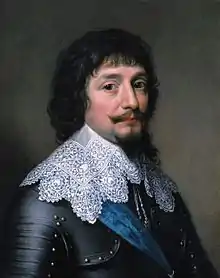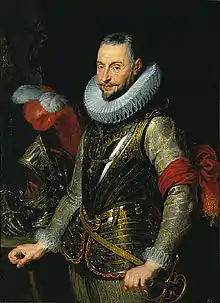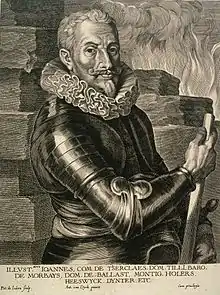Palatinate campaign
The Palatinate campaign, or the Spanish conquest of the Palatinate took place from 1620 to 1622, the Palatinate Phase of the Thirty Years' War.[6]
| Palatinate campaign | |||||||
|---|---|---|---|---|---|---|---|
| Part of the Thirty Years' War | |||||||
 Frederick V of the Palatinate, the Winter King | |||||||
| |||||||
| Belligerents | |||||||
|
Protestant Union |
| ||||||
| Commanders and leaders | |||||||
|
Ernst von Mansfeld |
| ||||||
| Strength | |||||||
| 25,000–30,000 (Mostly German and English troops)[3] |
25,000–30,000 [4] 11.000 under general Córdoba in the Lower Palatinate in 1621[5] | ||||||
The Palatinate was invaded by an Imperial-Spanish army under Don Ambrosio Spinola, Johann Tserclaes, Count of Tilly and Don Gonzalo de Córdoba. They defeated Protestant forces led by Frederick of the Palatinate, Baden-Durlach, and Mansfeld.[7]
It ended with Frederick's exile, and the Palatinate divided between Spain and Maximilian of Bavaria.
Background
The Thirty Years War began in 1618 when the Protestant-dominated Bohemian Estates offered the Crown of Bohemia to Frederick of the Palatinate, rather than the conservative Catholic, Emperor Ferdinand II. Most of the Holy Roman Empire remained neutral, viewing it as an inheritance dispute, and the revolt was quickly suppressed. However, with neither Ferdinand nor Frederick prepared to back down, Imperial forces invaded the Palatinate; removal of a hereditary prince changed the nature and extent of the war.[8]
Other Protestant powers became involved, among them James VI and I, king of England and Scotland, whose daughter Elizabeth was Frederick's wife. Protestant states within the Empire saw it as a threat, including external powers who held Imperial territories; Nassau-Dillenburg was a hereditary possession of the Dutch Prince of Orange, while Christian IV of Denmark was also Duke of Holstein. The war coincided with the end of the 1609 to 1621 Twelve Years' Truce between the Dutch Republic and Spain, and provided an opportunity for France, who faced a series of Spanish-backed Huguenot rebellions.[9]
The campaign

Commanded by Córdoba and Spinola, 25,000 men from the Army of Flanders left Brussels in August 1620, and entered the Lower Palatinate in early September. By 1 October, they had taken Kreuznach, Oppenheim, and Bacharach, and occupied the Bergstrasse district.[4]
Mainz fell to Córdoba in August 1621, while Spinola besieged Jülich; it surrendered in February 1622, cutting the supply route between the Dutch Republic and the Upper Palatinate.[10]
In March, Tilly and the army of the Catholic League invaded from Bavaria; he was intercepted by Protestant forces under Baden-Durlach and Mansfeld, leading to the inconclusive Battle of Mingolsheim on 27 April.[11]
Mansfeld then moved onto Ladenburg, while Baden-Durlach pursued the Bavarians; unaware Tilly had linked up with Córdoba, on 8 May, he was defeated at Wimpfen.[11] Operations were then halted by disease.[12]
By early November, Imperial-Spanish forces captured Heidelberg and Mannheim, the two leading cities in the Lower Palatinate.[7] Frederick fled into exile in the United Provinces. The Spanish occupied the western part of the Palatinate, cementing their control of the strategic corridor known as the Spanish Road; Maximilian of Bavaria took the rest.[6]
The Protestant army in the Palatinate contained volunteers from many countries, including several English regiments, led by Sir Horace Vere. Concentrated at Frankenthal, they were left isolated by defeats elsewhere, and in March 1623, James instructed them to surrender, ending the campaign.[13]
Aftermath

James' instructions to De Vere were based on the assumption he had agreed a deal with Philip IV to restore Frederick to his possessions, but this proved not to be the case. In February 1623, Ferdinand removed Frederick as one of the seven Imperial Prince-electors, his vote going to Maximilian of Bavaria.[14]
On 6 August, Tilly defeated a Protestant army under Christian of Brunswick in the Battle of Stadtlohn, and Frederick signed an armistice with Ferdinand, ending the "Palatine Phase" of the Thirty Years' War. Ferdinand declared Bohemia a hereditary Habsburg possession, confiscated land from the Protestant nobles who led the revolt, and embarked on a Catholic Counter-Reformation.[6]
This ensured the war would continue, and in 1624, England, France, the Dutch Republic, Sweden, Denmark-Norway, the Duchy of Savoy, the Republic of Venice, and Brandenburg created an anti-Habsburg alliance.[6]
References
- Sunshine / Hill p.219
- Black p.130
- Guthrie 2001, p. 93.
- Pursell 2003, p. 113.
- Wilson 2009, p. 331.
- Spielvogel 2006, p. 447.
- Black 2002, p. 130.
- Wilson 2009, pp. 314-316.
- Hayden 1973, pp. 1-23.
- Lawrence 2008, p. 82.
- Wilson 2009, p. 335.
- Antonio Fonseca, De epidemia febrili grassante in exercitu regis catholici in inferiori palatinatu, anno 1620 et 21 (Mechelen, Henry Jaye, 1623) – an account of the epidemic that decimated Spanish forces in the Lower Palatinate, available on Google Books.
- Pursell 2003, pp. 182-185.
- Pursell 2003, p. 195.
Sources
- Black, Jeremy (2002). European Warfare, 1494-1660 (Warfare and History). Routledge. ISBN 978-0415275316.CS1 maint: ref=harv (link)
- Guthrie, William P (2001). Battles of the Thirty Years War: From White Mountain to Nordlingen, 1618-1635. Greenwood Press. ISBN 978-0-313-32028-6.CS1 maint: ref=harv (link)
- Hayden, J Michael (1973). "Continuity in the France of Henry IV and Louis XIII: French Foreign Policy, 1598-1615". The Journal of Modern History. 45 (1). JSTOR 1877591.CS1 maint: ref=harv (link)
- Sunshine, Glenn S. (2005) Ron Hill The Reformation for Armchair Theologians. Westminster John Knox Press ISBN 978-0-664-22815-6
- Lawrence, David R (2008). The Complete Soldier: Military Books and Military Culture in Early Stuart England, 1603-1645. Brill. ISBN 978-90-04-17079-7.CS1 maint: ref=harv (link)
- Josef V. Polišenský/Frederick Snider: War and society in Europe (1618-1648). Bristol: Cambridge University Press, 1978. ISBN 978-0-521-21659-3
- Pursell, Brennan C (2003). The Winter King: Frederick V of the Palatinate and the Coming of the Thirty Years' War. Ashgate. ISBN 978-0-7546-3401-0.CS1 maint: ref=harv (link)
- Spielvogel, Jackson (2006). Western Civilization: Volume II, post 1500. Wadsworth Publishing. ISBN 978-0-534-64604-2.CS1 maint: ref=harv (link)
- Wilson, Peter (2009). Europe's Tragedy: A History of the Thirty Years War. Allen Lane. ISBN 978-0713995923.CS1 maint: ref=harv (link)